The Practice of Peace
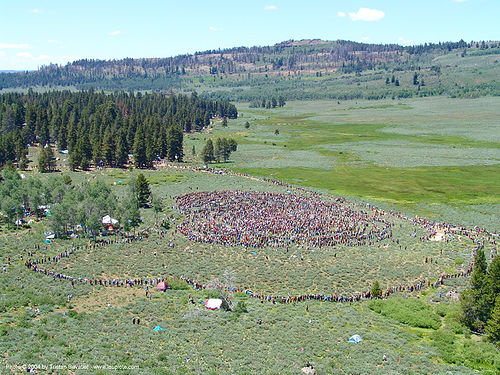
Picturing
The April editorial offered a picture, drawn chiefly from reports by gifted children, of variously-colored light streaming out of humans and other animals. Different visionaries may or may not agree in what they see or what a given color signifies. But they generally report clear, beautiful colors when the person viewed is in a loving or otherwise positive state of mind, whereas gloomy, turbid colors correspond to depressed states, and sharp projectiles to anger. Such reports resemble the conception of ki discussed in the March issue as a powerful stream of energy directed outwards in the martial arts, energy which, in aikido especially, is understood to be either violent and destructive, or peaceful and affirmative.
While it is unwise to dismiss these ideas out of hand, and worthwhile to pursue them further, one need not accept their literal truth in order to profit from these pictures and what they imply. Our intention is to further the cause of peace and justice in the world for all beings, not only our animal cousins but ourselves and our human sisters and brothers. We know we will be more effective in our outreach when we ourselves can deal with hostility without losing our balance--when we can encompass the destructive critic with compassion--when more and more we become the change we seek. We want to send out beautiful, loving energy rather than the muddy, out-of-control kind.
It is hardly necessary to point out how difficult this is. We may be able to react with love sometimes when we are attacked , but how are we to gain the strength to operate this way in a reliable manner? An important part of the answer, as suggested in some past editorials, is to be found in maintaining a spiritual discipline.
Holding
Spiritual disciplines vary, yet certain characteristics recur in many of them. One factor is learning to hold steadily in mind the ultimate goal. This does not mean that the practitioner gives up making plans for the immediate and middle future, or engaging with the surrounding world as it is. It means that s/he keeps her "eyes on the prize," whether that prize be understood as the Beloved, the Kingdom of God, the prevalence of Divine Light, the Peaceable Kingdom, the Repair of the World, or however it may be conceived. The practice of holding the Ultimate either in the forefront of one's mind (in contemplation or meditation) or in the back of the mind (during daily activities) is close to what some Western mystics call "Recollection." It means remembering the Ultimate at all times, a state that takes a long time to achieve. But along the way, as distractions in prayer or meditation are increasingly resisted, the practitioner's concentration increases in power, and the Desideratum comes just a little closer to realization, both in the practitioner's spirit and in the world. Eventually this powerful focus on the goal comes to permeate and inform one's daily life, so that virtually nothing can disrupt it.
Releasing
Another characteristic typical of spiritual disciplines, particularly those bound up with action in the world, may initially seem somewhat incompatible with the first. In contrast to the difficult work of achieving Recollection free of distraction, this concept is encapsulated in the popular adage "Let go, and let God." Poet John Greenleaf Whittier, an impassioned activist who dedicated many years of his life to working toward the abolition of human slavery, was also able to write, in lines which became a much-beloved hymn,
. . . With that deep hush subduing all
Our words and works that drown
The tender whisper of Thy call,
As noiseless let Thy blessing fall
As fell Thy manna down.
Drop thy still dews of quietness
Till all our striving cease;
Take from our souls the strain and stress
And let our ordered lives confess
The beauty of thy peace.
Breathe through the heats of our desire
Thy coolness and thy balm;
Let sense be dumb, let flesh retire,
Speak through the earthquake, wind, and fire,
O still, small Voice of calm.
We are to do without doing; we are to let the divine Spirit do his/her work through us. Notice that Whittier's hymn does not simply tell us to stop our feverish striving, as though it were only a matter of deciding and carrying out the decision. The hymn is a prayer that God will enact this state, stilling the inner noise, and thus enabling us to let him [her] speak and act through us. It is a cooperation both in non-work and work.
There is after all no incompatibility between this principle and that of holding to the goal. The letting-go is only the giving up of our claims upon both our work and its outcome. Both work and outcome are God's. The Bhagavad Gita, which spoke strongly to Gandhi after his encounter with the Sermon on the Mount, puts it in another way. It urges, in effect, that we should do our designated work, whatever it is, out of love for God rather than to garner the fruits of our labor. It means that we are to let go of the need to achieve, to succeed; in all our work, it is God we are to be serving, moment by moment. We animal defenders do not cease to love and serve our animal cousins, but even their liberation and healing are not the last word. The last word is God.
Uniting
Another factor in many of the spiritual disciplines of action in the world is what philosopher Michael Grosso calls "symphonic thinking," though we might supplement it with "symphonic prayer." He derives the term from Matt. 18:19, "If two of you agree on earth about anything that they may ask, it shall be done for them by my father in heaven." (Grosso points out that the Greek word for agree used here is symphonein, literally, sounding together.) The saying is hyperbolic, but points to an important principle: a spiritual gathering or community has greater power than its participants as separate individuals. Friends know well that it is as a community that we are to seek God within; the joint energy of the (primarily) silent gathering helps to give each participant freer access to the divine.
The principle of increase of power via symphonic thinking and prayer may seem painfully unhelpful to many isolated individuals who would like nothing better than to belong to a worship group who could unite with them in this quest, but whose family, friends, and/or church resist the animal concern. They are not as alone as they may feel, however; the power of symphonic thinking and prayer are not limited to the dynamics of a face-to-face group, important though that is. Just as a healing-prayer circle may function with one or more members joining in at a distance, so those who seek the healing of the world in its relation to our animal cousins may still, in prayer and contemplation, contribute to the power of the whole community of those who seek the same goal. Keeping in touch by electronic and other means across the miles not only gives us emotional support, it undoubtedly aids the spiritual work done by the whole group, which is the spiritual family of all who seek the healing of the world.
--Gracia Fay Ellwood
The structure of this editorial, and a little of the content, is derived from Michael Grosso's essay "The Parapsychology of God" in Body Mind Spirit, edited by Charles T. Tart.
A worldwide prayer group called Prayer Circle for Animals was established to harness the power of symphonic thinking/prayer toward furthering the cause of healing and liberation for all beings. Members commit to saying a single-line prayer once each day. See
www.circleofcompassion.org
Unset Gems
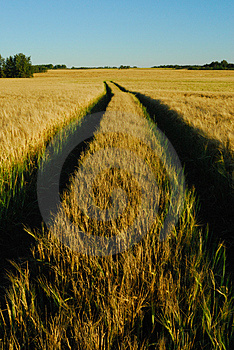 "I would love to see feedlots close and factory farming end. I would love to see more families return to the land . . . . I would love to know that I've wandered into my nation's heartland by the sweet smell of grain and not the forbidding smell of excrement.
"I would love to see feedlots close and factory farming end. I would love to see more families return to the land . . . . I would love to know that I've wandered into my nation's heartland by the sweet smell of grain and not the forbidding smell of excrement.
When you can't take it with you, all that really matters is what you leave behind."
--Howard Lyman
News Notes
Swine Flu and Factory Farms
There is more than a little evidence that the current epidemic of swine 'flu is linked to factory-farm practices in which animals are crammed together and wastes accumulate. The Humane Society cites Michael Greger, author of Bird Flu: A Virus of Our Own Hatching, to support this claim. See hsus.typepad.com/wayne/2009/04/swine-flu.html. Hope Bohanek urges us to write letters to the editor about this connection.
Another influenza authority, Mike Davis, who wrote The Monster At Our Door, points out that the resistance of animal agribusiness to reforms based on expert opinions such as these shows the monstrous power of the industry, and its disregard for human health, the health of the planet, and animal well being. See www.guardian.co.uk/commentisfree/2009/apr/27/swine-flu-mexico-health
--Contributed by Hope Bohanek and Lorena Mucke
Quakers and Jains Join in Inter-Faith Event
Nitin Mehta, founder of The Young Indian Vegetarian, invited the clerk of Britain's Quaker Concern for Animals, Marian Hussenbux, to speak at an interfaith event in Manchester on April 18. Marian described the work of QCA and told a little about the Quaker faith to some 100 members of the Jain community in that city.
Among the participants were Hare Krishna devotees. A Krishna monk spoke about his favorable contacts with Friends, and his group's support of a cow sanctuary in the south of England. A Finnish vegan told about his personal pilgrimage from his early days as a hunter. Lesley Tarleton then received the Mahaveer Award for her thirty years of work for animals in the two Freshfields Shelters, near Liverpool and in north Wales.
--Contributed by Marian Hussenbux
"Why We Need Animals"
Calvin College, a denominational liberal arts school in Grand Rapids, Michigan, held the second in its annual "Animals and the Kingdom of God" lecture series on May 1. Emphasizing the importance of spirituality, as focused in the image of God's Breathing, process philosopher Jay McDaniel gave an absorbing presentation entitled "Why We Need Animals--and God Does Too." This series is one manifestation of the vital animal concern movement among faculty and students in this somewhat conservative college.
Molly Moves Out
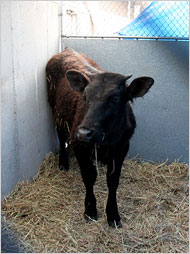 A black heifer named Molly escaped while being unloaded at a slaughterhell in Queens, New York, and ran through the streets for about an hour. She was captured by police and taken to an animal sanctuary on Long Island. She has a built-in new friend there, a five-year-old steer named Wexler, and appears to be all set for a long and happy life. Would that all our animal cousins--God's creatures--could find this kind of Peace.
A black heifer named Molly escaped while being unloaded at a slaughterhell in Queens, New York, and ran through the streets for about an hour. She was captured by police and taken to an animal sanctuary on Long Island. She has a built-in new friend there, a five-year-old steer named Wexler, and appears to be all set for a long and happy life. Would that all our animal cousins--God's creatures--could find this kind of Peace.
See cityroom.blogs.nytimes.com/2009/05/07/farm-living-is-the-life-for-molly-the-calf
--Contributed by Lorena Mucke
Letters
Dear Peaceable Friends,
Thank you for managing this Quaker vegetarian newsletter. Vegetarianism is probably now at the point slavery once was for Friends, so where is the next John Woolman?
I was however, disappointed about the superstition type material in colors of thoughts, etc. If that phenomenon was verified, it would not long be little known but would make headlines and get huge research study from the neurological sciences. However it doesn't seem about to do that. Auras have been reported in pseudo-science since I was a child 50+ years ago and I believed all the accounts then. But after all this time, it seems still to be one of those elusive anecdote areas much like UFOs and séances.
I think the vegetarian issue is more ethical, and now environmental. It is well defined on a 10 minute video called "A Life Connected" available from www.nonviolenceunited.org. . . .
--Steve Willey
It would be a wonderful thing if we could count on the science establishment to research in depth any phenomena with important implications for our lives, and make their findings public. Unfortunately, we can't be assured they will; sometimes studies of borderline topics do appear, but there may also be suppression of such reports. Most people, including scientists, have their prejudices, usually regarding matters that threaten their professional standing, their worldviews, or their salaries. Those in charge of awarding grants or making decisions about whether to publish an essay or to grant job tenure may dismiss out of hand the evidence presented in a particular study, however strong it may be, if the conclusions it suggests are unwelcome to them. Emotionally weighted terms like superstition and anomaly and anecdotal can be used to justify dismissal. Philosopher of science David Ray Griffin explores this subject at length in his book Parapsychology, Philosophy, and Spirituality.
Many readers of PT know that some of these same suppressive tendencies appear in the interface among nutrition studies, government, and big business, as T. Colin Campbell documents in the last section of The China Study. In view of these complicating factors, we do well to maintain a stance of openness on borderline issues, weighing evidence for ourselves as best we can, and being prepared to stand either with the many or the few, as we are led by the evidence and by our ethical commitments.
A Life Connected is indeed an effective and succinct statement of the animal concern, one which which I highly recommend.
--Gracia Fay Ellwood
Glimpses of the Peaceable Kingdom
I and Thou
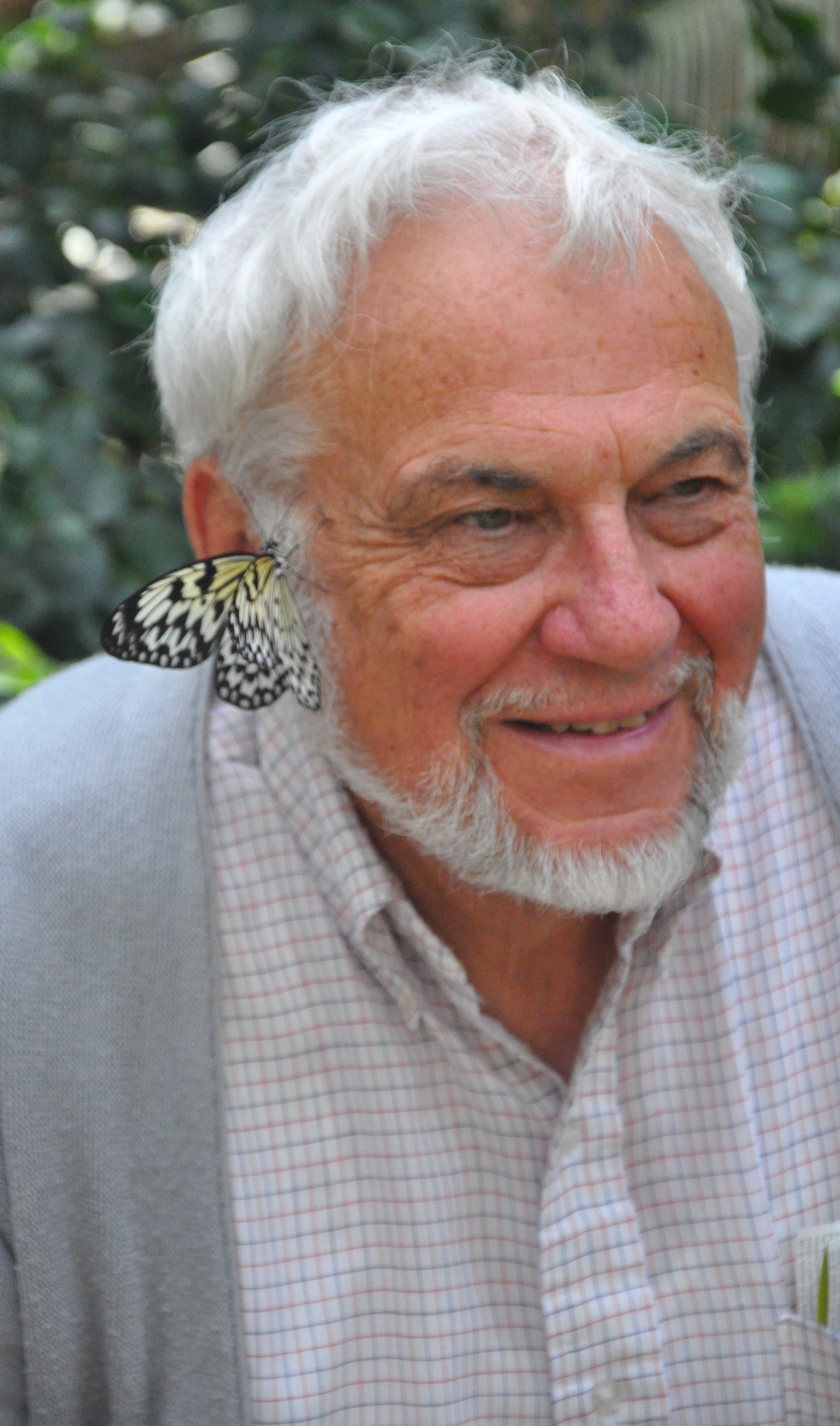 Recently a member of the PT staff, reviewer Robert Ellwood, visited the Frederick Meijer Gardens in Grand Rapids, Michigan. After he had walked in the huge glass-enclosed butterfly garden for a time, and had taken a seat on a bench, he had a small and delicate visitor who wanted to share the moment. She (or he) remained for four or five minutes. fluttered about briefly, then settled down again. Photographer Jessica Herringa came upon the peaceable scene and took this photo, along with several others.
Recently a member of the PT staff, reviewer Robert Ellwood, visited the Frederick Meijer Gardens in Grand Rapids, Michigan. After he had walked in the huge glass-enclosed butterfly garden for a time, and had taken a seat on a bench, he had a small and delicate visitor who wanted to share the moment. She (or he) remained for four or five minutes. fluttered about briefly, then settled down again. Photographer Jessica Herringa came upon the peaceable scene and took this photo, along with several others.
The Diet of Paradise
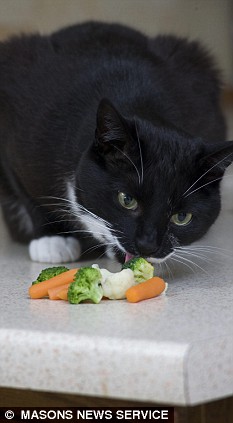 A white-vested black kitten was found half-starved in an alley in a town near Norwich, England, two years ago by Becky Page, an young earth-mother type who has taken in several other animals and grows an organic garden. Becky tried to fatten the kitten up with chicken and fish, but he would have none of it. However, some leftover vegetables on a plate near the refuse bin was just what the kitten had in mind, and he gobbled them up. Ever since then, Dante, as Becky appropriately named him, has dined off the good things from her garden, as well as certain choice fruits, and become healthy and strong. He has not been seen doing any hunting, preferring the indoor scene.
A white-vested black kitten was found half-starved in an alley in a town near Norwich, England, two years ago by Becky Page, an young earth-mother type who has taken in several other animals and grows an organic garden. Becky tried to fatten the kitten up with chicken and fish, but he would have none of it. However, some leftover vegetables on a plate near the refuse bin was just what the kitten had in mind, and he gobbled them up. Ever since then, Dante, as Becky appropriately named him, has dined off the good things from her garden, as well as certain choice fruits, and become healthy and strong. He has not been seen doing any hunting, preferring the indoor scene.
Like a human mother worried that her vegetarian child won't get enough protein, Becky occasionally slips a bit of meat among Dante's veggies. If he spots it, he leaves it in his dish. It seems that, having tasted the joys of the Peaceable Kingdom, this highly-evolved kitty has no intention of sliding down the ladder into culinary violence. See 329.blogspot.com/2009/04/dante-vegetarian-cat.html
--Contributed by Diana Dunningham Chapotin and Marjorie Emerson
Book Review: Animals Matter
Marc Bekoff, Animals Matter. Forward by Jane Goodall. Boston and London: Shambhalla, 2007. Pp. 202. $14.00 softcover.
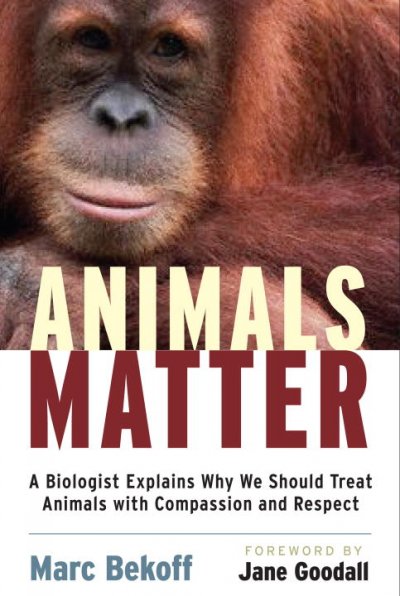 Marc Bekoff has emerged as one of the most insightful and readable writers in animal issues. He is now an emeritus professor of biology at the University of Colorado (a relationship in which I, as a graduate of the same university, take great pride). He is the author of such important works as The Emotional Lives of Animals (2007) -- a field in which he is a particularly forceful spokesperson -- and an earlier version of the present book, Strolling with our Kin: Speaking for and Respecting Voiceless Animals (2000). Without sacrificing substance, Bekoff has a knack for presenting material with clarity together with the use of engaging illustrative material that should make Animals Matter, like his other books, accessible to a wide spectrum of readers. The concise volume seems intended chiefly for college students and other young adults, but should commend itself to persons of all ages as an introduction to the whole range of animal-related issues, or as a helpful review of them and the principal literature for the already-initiated.
Marc Bekoff has emerged as one of the most insightful and readable writers in animal issues. He is now an emeritus professor of biology at the University of Colorado (a relationship in which I, as a graduate of the same university, take great pride). He is the author of such important works as The Emotional Lives of Animals (2007) -- a field in which he is a particularly forceful spokesperson -- and an earlier version of the present book, Strolling with our Kin: Speaking for and Respecting Voiceless Animals (2000). Without sacrificing substance, Bekoff has a knack for presenting material with clarity together with the use of engaging illustrative material that should make Animals Matter, like his other books, accessible to a wide spectrum of readers. The concise volume seems intended chiefly for college students and other young adults, but should commend itself to persons of all ages as an introduction to the whole range of animal-related issues, or as a helpful review of them and the principal literature for the already-initiated.
This book is unapologetically plainspoken about animals and what they can suffer. It resolutely dismantles the scientific and commercial jargon behind which realities of cruelty or the heedless commodification of animals are all too often hidden. This task is further aided by a unique glossary which explains in easy language terms commonly used in animal studies and by animal activists. Study is further helped by questions and "thought experiments" at the ends of the chapters; these encourage the reader to consider all points of view and work through issues for oneself.
The chapters themselves cover the major provinces of animal concerns.
After the Introduction, the book presents "Animals in a Human World," chapter 2, and "Animal Sentience," chapter 4, which focus on the areas in which Bekoff is a leading expert: animal emotions, their ability to experience both joy and pain intensely, the meaning of animal play, and what all this signals for human responsibility. Chapter 3, "Making Decisions about Animal Use," includes significant discussions of animal intelligence and personhood, topics about which we are gaining rapidly increasing, and increasingly impressive, information. The author makes clear that while animals may have information-sensing and decision-making capacities different from those of humans, that does not mean these capacities are not genuine, or as sophisticated as ours in their own spheres of intended use.
Later chapters deal with the perennial question of animal rights versus animal welfare, utilitarian philosophy ("the greatest good to the greatest number" -- including animals in those numbers), the competing claims of different species (e.g., was the reintroduction of wolves to Yellowstone, with the corresponding decimation of elk and coyotes, wise or not?), the question of zoos, and finally the pre-eminent issues of eating and experimenting upon animals. It will be immediately apparent that Bekoff does not avoid tough questions. He does not hesitate to acknowledge that they are tough, and does not claim to have all the answers. But he makes no bones about the fact that allowing animals simply to be themselves, living their own lives in their own way, is a very high priority for him.
In conclusion, Animals Matter is a thoughtful and useful book, appropriate both for the committed and for those who just want to know what the animal talk is all about. Its level and organization, including the questions and thought material, would make it an ideal source for meeting, church, or school discussion groups around animal issues. It deserves a wide circulation.
--Robert Ellwood
Film Review: Earth
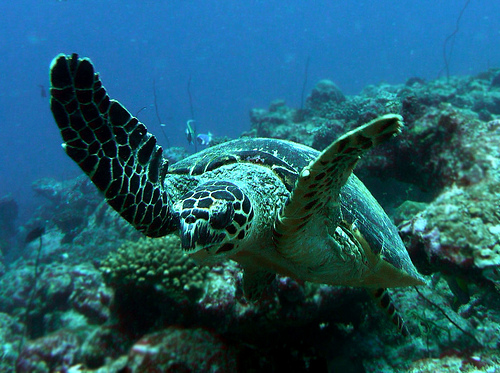
Earth. A documentary film, produced by the BBC in 2007, and released in the USA on April 22 (Earth Day), 2009, by Disneynature films. Written and directed by Alastair Fothergill and Mark Linfield, produced by Sophokles Tasioulis and Alix Tidmarsh. Narrated by Patrick Stewart in the 2007 British version, by James Earl Jones in the 2009 American version. Rated G. Running time 1 hour and 29 minutes.
A survey of life on our planet, from the Arctic to the Antarctic, from January to December, this film has the most awe-inspiring, overwhelming photography that I have ever seen. Ice caps, deserts, forests, prairies, oceans, mountains, flocks and herds are displayed in views that in former centuries only Omniscience could have seen.
As might be expected, here is a good deal of emphasis on animals in the wild. Beauty is of course not the whole story. The most sensitive souls may be greatly distressed by a number of scenes of predators and prey. These include: A wolf hunting a young caribou. The camera cuts away before the actual killing, and the death is offscreen. (I confess that hat did not stop my tears from flowing.) Sharks eating seals, a scene of surrealistic horror. A cheetah hunting an antelope. This time the camera does not pull away. On the contrary, the slaying is in slow-motion, with haunting music in the soundtrack. "A terrible beauty is born," as the poet Yeats says. A pride of lionesses (with their lord supervising) attacking a full-grown elephant at night, when their night vision gives the big cats an unfair advantage. We do not see the moment of death, with the film instead focusing instead on the thunder and lightning. The scene arouses overwhelming horror and pity. A polar bear, desperate to find prey in the Arctic, which has been drastically changed by global warming, dares to attack a whole tribe of walruses. He is too weak and hungry to slay a full-grown walrus, and the adults are unfailingly protective of the babies. In the end, the defeated Nanook lies down to die of starvation, a victim of what we human beings have done to the planet.
For relief, there are plenty of comic scenes: Mandarin ducklings "fly" down from their birth-tree, looking uncannily like flying squirrels; baboons wade through flooded bushland, doing a comic dance (perhaps this is how our ancestors learned bipedalism?); male birds of paradise try, in vain, to dance their way into a female's heart.
And there are inspiring, dramatic moments, such as demoiselle cranes flying over the Himalayas--viewers will be cheering for these brave and beautiful birds--and a mother humpback whale teaching her calf to swim and to breathe.
The film is of course, very educational. Just one example: the viewer learns that there is a huge coniferous forest in the north that supplies a third of the world's oxygen.
All the wild beauty will stay with you for a long time, and, hopefully, inspire you to do all in your power to help save our planet. The film does not connect the threatened demise of much of this beauty to the human ignorance, greed, and violence tied up in massive animal agribusiness and similar industries, but those of us who know will be strengthened in our commitment to simple living and a vegan diet.
Capsule Film Review: Knowing
KNOWING. An Escape Artists film. Directed by Alex Proyas. Starring Nicholas Cage as Professor John Koestler and Chandler Canterbury as Caleb Koestler. Rated PG-13. 2009.
The PG-13 rating of this science fiction film is not due to any sensuality or suggestive language, but to numerous scenes of apocalyptic violence, with dreadful suffering of many humans and animals. For the same reasons, I cannot really recommend this time-capsule story to PT readers, who are a sensitive lot, and I choose not to provide a full-length review. I will say only that the film begins and ends with young Caleb, age 9, an intelligent, sensitive, animal-loving child who is the best hope for the survival of a small part of humanity through the coming destruction and horror, much like the heroine of THE LAST MIMZY. In fact, at the very beginning of the story, we see him lovingly holding a rabbit and refusing to eat his father's hot dogs, because of his compassionate vegetarian convictions. The implied message: only one who opts for love rather than violence can get through the fire to a beautiful new world.
--Benjamin Urrutia
Recipes
Raspberry Muffin Cake
One 9 inch x 9 inch cake
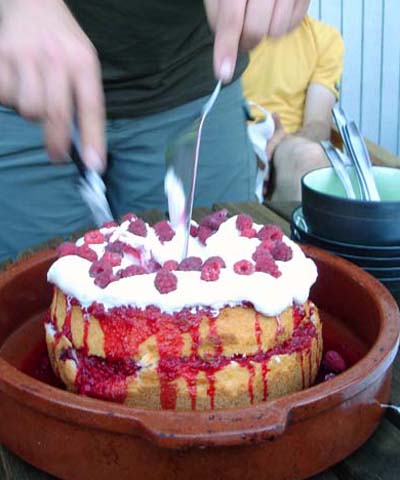 2 cups organic unbleached flour
2 cups organic unbleached flour
¾ cup organic sugar
2 tsp. baking powder
½ tsp. ground cinnamon
½ tsp. sea salt
⅓ cup canola or safflower oil
1 ¼ cup soy or rice milk, vanilla flavor
2 tsp. raspberry vinegar
1 cup frozen raspberries
Preheat oven 350° F.
In medium sized bowl, stir together dry ingredients. Add canola oil, soy milk and vinegar; stir well until smooth with a wooden spoon. Batter should be fairly thick. Then stir in raspberries. Spoon into a 9 inch x 9 inch baking dish, which has been sprayed with non-stick cooking spray. Sprinkle top with additional cinnamon and sugar. Bake until toothpick comes out clean – about 40 minutes. Serve warm with coffee or tea.
Other fruit such as blueberries may be used.
Angela Suarez
Mango, Red Pepper and Black Bean Salad
3 - 4 servings
3 cups cooked black beans
1 ½ cups fresh or frozen yellow corn
½ large sweet red bell pepper, chopped
1 mango, peeled and cut into small chunks
1 small sweet onion, chopped
3 T. extra-virgin olive oil
1 T. seasoned rice vinegar
1 tsp. chili powder
1 tsp. ground cumin
1 tsp. sea salt, or to taste
In a large deep salad bowl, place beans, corn, red pepper, mango and onion. In a small bowl, whisk together olive oil, rice vinegar and spices. Pour over bean mixture and toss well to coat all ingredients. Adjust seasonings as needed. Serve over brown or basmati rice and a bed of greens.
Angela Suarez
My Pilgrimage: Carl Sheppard
The Indelible Etching
Thanks to the role played by my bighearted older brother Jerry, who convinced me, in very short order, to start on my pilgrimage, the day I became a vegetarian is indelibly etched into me.
Meat Was Everywhere
I was raised in the South, in a meat-and-potatoes home where nearly every dish, from navy beans with ham hocks to collard greens with fat back, had some kind of animal product in it. As a boy not knowing any better, I had feasted with delight on all those dishes, with no regrets at all. However, Jerry, who was the hippie-minded, counter-culture, "black sheep" member of the family, began at some point to question our diet, much to our parents' dismay. He stopped eating some of our thrice-daily fare. Unfortunately, before I came to know the reasons behind his rebellion, he ran away from home to escape the repressive parents-always-know-best atmosphere in our home, and to find his own way. I was only ten then, Jerry was sixteen; it was to be many years before he was heard from again.
I went on in my carnivorous ways. Right up to and into the Air Force, I went on eating meat whether it was served by my parents or obtained on my own. My first AF duty station was in Texas where the motto is "cattle is king" (although cattle are of course the slaves); so a night at the steak house was a regular affair. Then, at the age of twenty, I received a hardship discharge to go home and help my family through some rough waters.
The Phone Call
So I was back in my home town, living with my younger brother just a few blocks from the house I'd grown up in, when when the phone rang one day. To my great surprise, I heard the voice of long-lost brother Jerry. He had been living in Puerto Rico, and now, on his way to Hawaii, was on layover at the local airport. I talked him into extending his layover for several days and was soon on my way to the airport.
The person I saw at curbside did not look like the crewcut kid that I had known; he looked like traditional pictures of Jesus, but with wire rimmed glasses, yoga pants, and a white cotton pullover shirt. He looked very mellow--and believe me, he was just that.
Back at my house, after we'd caught up on some family news, he began to tell me of his adventures after leaving home. He had made his way to Montreal, Canada, where he had met up with and spent considerable time with Hare Krishna devotees. He had not become a full-fledged follower, but had read some Vedic texts and had become a vegetarian.
A New World Opens
He then began what I thought of as preaching at me (though now I see it as teaching me) about the bad karma of a meat-based diet. These ideas were all so new, and involved so huge a change, that I hesitated. He told me I needed to read the Bhagavad-Gita. I found it at the local library, and spent the next two days absorbing what it had to say about the pitfalls of the only style of diet I knew. It told me that "The humble sages, by virtue of true knowledge, see a learned and gentle clergyman, an outcaste from society, a cow, an elephant, and a dog as spiritual equals" (5:13), in that they are all eternal souls trapped in different, temporary bodies. "Wow! What a concept," I thought. "I'm no better than a cow--what right do I have to kill and eat one?"
Now, I had been raised a Christian, and there is an expression of this concept in the Bible--"For the fate of humans and of animals is the same . . . . They all have the same breath, and humans have no advantage over the animals . . ." (Eccl. 3:19) Yet the nuns and priests who gave me twelve years of education, and who also dined on the beasts, had never pointed out the significance of this verse to me. My brother (and the Gita) also spoke of the law of karma. This idea of receiving the consequences of our acts also appears in the Bible--"Do not be deceived, God is not mocked; for whatever a man sows, this he will also reap" (Gal. 6:7) but I had failed to get that picture too. Jerry taught me about the cruelty inherent in a meat-based diet, which certainly made my karmic debt seem like one I wouldn't be very eager to pay off! But he also explained about the great nutritional value of a meat-free, plant based diet.
Burying the Past
So, after a good deal of soul-searching, on a day now twenty-eight years past I made the leap: no more eating of flesh. My brother congratulated me on my decision with a heartfelt hug, and then told me it was time to get all the "dead bodies" out of my house. First, he said, all "flesh products" would come out of the refrigerator and onto the kitchen table. Some were obvious: pork chops, hamburger. Other items surprised me: the yellow rice had chicken powder; the chili had beef powder; they too had to go. On and on we went, until most of my groceries were in the pile.
Just when I thought we were done, Jerry opened the fridge for one last look. Out came the mayonnaise and the eggs. "Eggs?" I said. "They're not meat." "They're liquid chickens," said my brother, which ended the debate.
"Now," I said, "what are we gonna do with all this food? Shall we call Dad and give it to him?"
"No, we don't want the bad karma." I was silent. "Well, what do most people do with dead bodies?" The answer was obvious, but I didn' t get it. He continued, "What are graveyards for?"
That one I couldn't miss, flabbergasted though I was. We carried all the corpses and residue into my back yard, got a shovel, and began to dig a deep grave. Everything culled from my fridge went in, and as we covered it all up, Jerry told me that if I prayed to Lord Krishna for forgiveness, and if I did not kill to eat again, I would also have buried my accumulation of meat-related karma as well. I had a great sense of cleansing, and felt so happy. The burial seemed like a most appropriate ritual to seal the occasion. The teaching was indelibly etched on my heart.
Gratitude
In the following twenty-eight years I have never once reconsidered my decision. And thanks to my good friends who produce The Peaceable Table, I'm leaning away from my dairy consumption toward total veganism.
I feel a debt of gratitude I cannot repay to my brother, to the Gita, and most importantly, to the Lord, for he is ultimately the cause of all causes. I often tell the story to others, using my brother's colorful language of "dead bodies" and "liquid chickens." I felt honored when I was invited to share my pilgrimage with the readers of The Peaceable Table as well.
May God bless you, bless us every one--every soul, every human being, every beast.
Pioneering Words: Michel de Montaigne, 1533-1592
 French essayist Michel de Montaigne wrote eloquently about the suffering of animals at human hands, especially in the hunt, and about human beings' presumption in considering themselves lords of all other creatures. But he never took his own implied advice and stopped eating the victims; it seems he even participated in hunting, though without using weapons himself. Had he walked his talk, he would be a true pioneer, providing us not only insight but inspiration and support.
French essayist Michel de Montaigne wrote eloquently about the suffering of animals at human hands, especially in the hunt, and about human beings' presumption in considering themselves lords of all other creatures. But he never took his own implied advice and stopped eating the victims; it seems he even participated in hunting, though without using weapons himself. Had he walked his talk, he would be a true pioneer, providing us not only insight but inspiration and support.
"For my part I have never been able to see, without displeasure, an innocent and defenceless animal, from whom we receive no offence or harm, pursued and slaughtered. And when a deer, as commonly happens, finding herself without breath and strength, without other resources, throws herself down and surrenders, as it were, to her pursuers, begging for mercy by her tears, this has always appeared to me a very displeasing spectacle. I seldom, or never, take an animal alive whom I do not restore to the fields. . . ."
"Dispositions sanguinary in regard to other animals testify a natural inclination to cruelty towards their own kind. After they had accustomed themselves at Rome to the spectacle of the murders of other animals, they proceeded to those of men . . . . Nature has, I fear, herself attached some instinct of inhumanity to man's disposition."
"Presumption is our natural and original disease. The most calamitous and fragile of all creatures is man, and yet the most arrogant. It is through the vanity of this same imagination that he equals himself to a god, that he attributes to himself divine conditions, that he picks himself out and separates himself from the crowd of other creatures, curtails the just shares of other animals his brethren and companions, and assigns to them such portions of faculties and forces as seems to him good. How does he know, by the effort of his intelligence, the interior and secret movements and impulses of other animals? By what comparison between them and us does he infer the stupidity which he attributes to them?"
--Quoted in Colin Spencer's The Heretic's Feast, pp. 188-89
Poetry : Joan Aiken, John Greenleaf Whittier
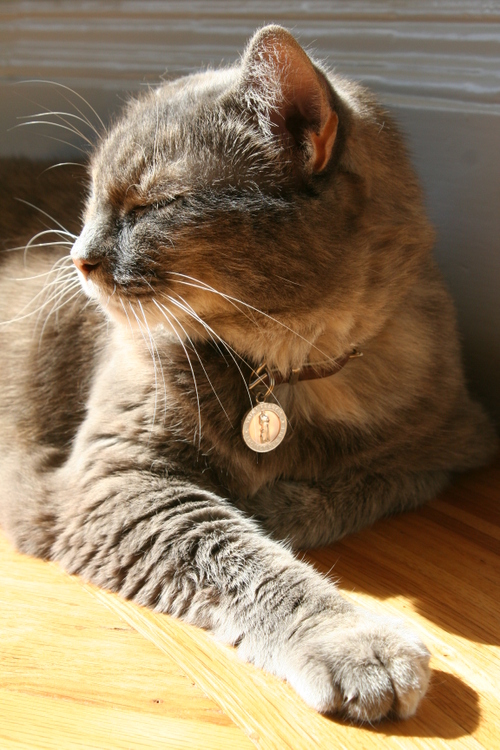
CAT
Old Mog comes in and sits on the newspaper
Old fat sociable cat
Thinks when we stroke him he's doing us a favour
Maybe he's right, at that.
--J. A.
FIRST-DAY THOUGHTS
In calm and cool and silence, once again
I find my old accustomed place among
My brethren; here, perchance, no human tongue
Shall utter words; where never hymn is sung,
Nor deep-toned organ blown, nor censer swung
Nor dim light falling through the pictured pane!
 There, syllabled by silence, let me hear
There, syllabled by silence, let me hear
The still small voice which reached the prophet's ear;
Read in my heart a still diviner law
Than Israel's leader on his tables saw!
Here let me strive with each besetting sin,
Recall my wandering fancies, and restrain
The sore disquiet of a restless brain;
And, as the path of duty is made plain,
May grace be given that I may walk therein,
Not like the hireling, for his selfish gain,
With backward glances and reluctant tread,
Making a merit of his coward dread,
But, Cheerful, in the light around me thrown,
Walking as one to pleasant service led;
Doing God's will as if it were my own,
Yet trusting not in mine, but in His strength alone!
--J.G.W.
The Peaceable Table is
a project of the Animal Kinship Committee of Orange Grove Friends Meeting, Pasadena, California. It is intended to resume the witness of that excellent vehicle of the Friends
Vegetarian Society of North America, The Friendly
Vegetarian, which appeared quarterly between 1982 and
1995. Following its example, and sometimes borrowing from its
treasures, we publish articles for toe-in-the-water
vegetarians as well as long-term ones, news notes, poetry, letters, book
and film reviews, and recipes.
The journal is intended to be
interactive; contributions, including illustrations, are
invited for the next issue. Deadline for the June issue
will be May 29, 2009. Send to graciafay@gmail.com
or 10 Krotona Hill, Ojai, CA 93023. We operate primarily
online in order to conserve trees and labor, but hard copy
is available for interested persons who are not online.
The latter are asked, if their funds permit, to donate $12 (USD) per year. Other
donations to offset the cost of the domain name and server are welcome.
Website: www.vegetarianfriends.net
Editor: Gracia Fay Ellwood
Book and Film Reviewers: Benjamin Urrutia & Robert Ellwood
Recipe Editor: Angela Suarez
NewsNotes Editors: Lorena Mucke and Marian Hussenbux
Technical Architect: Richard Scott Lancelot Ellwood

 "I would love to see feedlots close and factory farming end. I would love to see more families return to the land . . . . I would love to know that I've wandered into my nation's heartland by the sweet smell of grain and not the forbidding smell of excrement.
"I would love to see feedlots close and factory farming end. I would love to see more families return to the land . . . . I would love to know that I've wandered into my nation's heartland by the sweet smell of grain and not the forbidding smell of excrement. 
 A black heifer named Molly escaped while being unloaded at a slaughterhell in Queens, New York, and ran through the streets for about an hour. She was captured by police and taken to an animal sanctuary on Long Island. She has a built-in new friend there, a five-year-old steer named Wexler, and appears to be all set for a long and happy life. Would that all our animal cousins--God's creatures--could find this kind of Peace.
A black heifer named Molly escaped while being unloaded at a slaughterhell in Queens, New York, and ran through the streets for about an hour. She was captured by police and taken to an animal sanctuary on Long Island. She has a built-in new friend there, a five-year-old steer named Wexler, and appears to be all set for a long and happy life. Would that all our animal cousins--God's creatures--could find this kind of Peace. Recently a member of the PT staff, reviewer Robert Ellwood, visited the Frederick Meijer Gardens in Grand Rapids, Michigan. After he had walked in the huge glass-enclosed butterfly garden for a time, and had taken a seat on a bench, he had a small and delicate visitor who wanted to share the moment. She (or he) remained for four or five minutes. fluttered about briefly, then settled down again. Photographer Jessica Herringa came upon the peaceable scene and took this photo, along with several others.
Recently a member of the PT staff, reviewer Robert Ellwood, visited the Frederick Meijer Gardens in Grand Rapids, Michigan. After he had walked in the huge glass-enclosed butterfly garden for a time, and had taken a seat on a bench, he had a small and delicate visitor who wanted to share the moment. She (or he) remained for four or five minutes. fluttered about briefly, then settled down again. Photographer Jessica Herringa came upon the peaceable scene and took this photo, along with several others. A white-vested black kitten was found half-starved in an alley in a town near Norwich, England, two years ago by Becky Page, an young earth-mother type who has taken in several other animals and grows an organic garden. Becky tried to fatten the kitten up with chicken and fish, but he would have none of it. However, some leftover vegetables on a plate near the refuse bin was just what the kitten had in mind, and he gobbled them up. Ever since then, Dante, as Becky appropriately named him, has dined off the good things from her garden, as well as certain choice fruits, and become healthy and strong. He has not been seen doing any hunting, preferring the indoor scene.
A white-vested black kitten was found half-starved in an alley in a town near Norwich, England, two years ago by Becky Page, an young earth-mother type who has taken in several other animals and grows an organic garden. Becky tried to fatten the kitten up with chicken and fish, but he would have none of it. However, some leftover vegetables on a plate near the refuse bin was just what the kitten had in mind, and he gobbled them up. Ever since then, Dante, as Becky appropriately named him, has dined off the good things from her garden, as well as certain choice fruits, and become healthy and strong. He has not been seen doing any hunting, preferring the indoor scene. Marc Bekoff has emerged as one of the most insightful and readable writers in animal issues. He is now an emeritus professor of biology at the University of Colorado (a relationship in which I, as a graduate of the same university, take great pride). He is the author of such important works as The Emotional Lives of Animals (2007) -- a field in which he is a particularly forceful spokesperson -- and an earlier version of the present book, Strolling with our Kin: Speaking for and Respecting Voiceless Animals (2000). Without sacrificing substance, Bekoff has a knack for presenting material with clarity together with the use of engaging illustrative material that should make Animals Matter, like his other books, accessible to a wide spectrum of readers. The concise volume seems intended chiefly for college students and other young adults, but should commend itself to persons of all ages as an introduction to the whole range of animal-related issues, or as a helpful review of them and the principal literature for the already-initiated.
Marc Bekoff has emerged as one of the most insightful and readable writers in animal issues. He is now an emeritus professor of biology at the University of Colorado (a relationship in which I, as a graduate of the same university, take great pride). He is the author of such important works as The Emotional Lives of Animals (2007) -- a field in which he is a particularly forceful spokesperson -- and an earlier version of the present book, Strolling with our Kin: Speaking for and Respecting Voiceless Animals (2000). Without sacrificing substance, Bekoff has a knack for presenting material with clarity together with the use of engaging illustrative material that should make Animals Matter, like his other books, accessible to a wide spectrum of readers. The concise volume seems intended chiefly for college students and other young adults, but should commend itself to persons of all ages as an introduction to the whole range of animal-related issues, or as a helpful review of them and the principal literature for the already-initiated.
 2 cups organic unbleached flour
2 cups organic unbleached flour French essayist Michel de Montaigne wrote eloquently about the suffering of animals at human hands, especially in the hunt, and about human beings' presumption in considering themselves lords of all other creatures. But he never took his own implied advice and stopped eating the victims; it seems he even participated in hunting, though without using weapons himself. Had he walked his talk, he would be a true pioneer, providing us not only insight but inspiration and support.
French essayist Michel de Montaigne wrote eloquently about the suffering of animals at human hands, especially in the hunt, and about human beings' presumption in considering themselves lords of all other creatures. But he never took his own implied advice and stopped eating the victims; it seems he even participated in hunting, though without using weapons himself. Had he walked his talk, he would be a true pioneer, providing us not only insight but inspiration and support.
 There, syllabled by silence, let me hear
There, syllabled by silence, let me hear